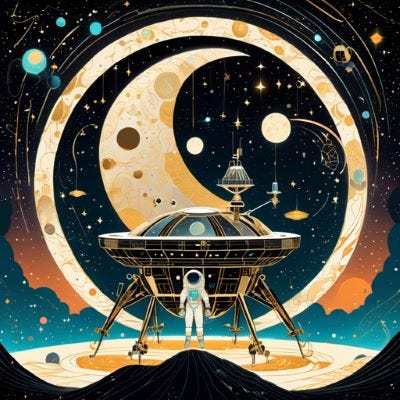Creation Node by Stephen Baxter
What if planet nine wasn't a planet? A space oddity.
After quite a bit of highbrow literary sci-fi, it’s time for some “real” science fiction: Take starships, space colonies, astronauts, and throw in aliens for good measure. Creation Node, a just published novel by Stephen Baxter has it all.
It’s been a while since Pluto has been stripped of its designation as a planet but the search for planet nine continues and a few years ago scientists first hypothesized that planet nine might not be a planet after all, but a so-called primordial black hole - a black hole not created during the death of a star but as a leftover directly from the big bang. Stephen Baxter uses that hypothesis as the starting point for his latest space adventure.
It is the year 2255 (not 2525) and a group of six conservers, one of the three factions of humanity besides those following earth’s government as earth is recovering from the disastrous effects of climate change and moon colonists trying to gain economic independence from earth, have completed a decades-long trip through the solar system to arrive in an area of space where they are expecting to find planet nine - the first people this far away from earth. Where the moon colonists are depicted as ruthless capitalists and the earth government is just that - a well-meaning but scheming government, the conservers are presented as a group formed as a result of earth’s climate crisis in the 21st century and following an ethos of minimal waste and damage, including in their space missions.
As the conservers aboard the Shadow approach the expected location of planet nine, they discover that the gravitational effects of planet nine - rather than coming from an actual planet - are caused by a tiny primordial black hole. More importantly: That black hole appears to be leaking information and seems to be inviting communication.
Startled by this discovery, a new space race begins with all factions of humanity trying to send expeditions to join the Shadow crew at its position to further explore this anomaly and we follow a group of diverse protagonists over a ten-year journey to meet up with the original Shadow crew. There is a lot of political scheming in this part of the book and we get a good view of some of the technological marvels of 23rd century space technology: Helium 3 mining on the moon and on Saturn, space elevators, space ships, and outposts deep in the solar system.
At the same time, it becomes obvious that bigger forces are at play at the edge of the solar system: Timed perfectly with the arrival at the black hole, a quasar lights up a the center of the Milky Way - or more precisely, a quasar has lit up 25,000 years ago and becomes visible in the solar system (threatening to restart global warming on earth) just as the crew of the Shadow makes contact with the black hole. A first indication that the crew are dealing with something far more powerful than just an ordinary black hole.
Baxter takes his time to expose the reader to some of the ideas that come fully to light in the last third of the book when a human delegation makes closer contact with the entity behind the black hole. Typical for many of Baxter’s books, Creation Node again ties a personal story of exploration to big ideas about the nature of the universe itself, forcing a small group of explorers to take a far reaching decision.
Baxter has written another gripping story here. As in some of his other books, the characterization of his cast can be a bit flat and stereotypical at times: Politicians are scheming, spaceship commanders are battle-hardened heros, and for a story spanning (initially) over a decade, there is very little character development. That said, Baxter knows how to craft a real page-turner that keeps the reader hooked from the first page to the last.
If you have read other books by Stephen Baxter, you will find some common themes: The multiverse, the evolution of the universe and the very distant future of space are themes Baxter has explored before, but he brings all of these ideas together in one fine package in Creation Node.
If you are looking for deep characters, this book is probably not worth your time. But if you want a good space adventure around some big ideas you will likely go through the over 400 pages of the book in no time. Well worth a read.


